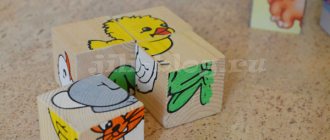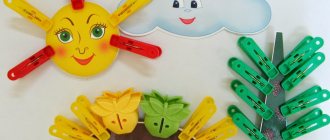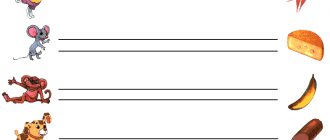Recipe for very flexible dough
And another recipe for a very, very soft, plastic, homogeneous and, I would even say, ideal dough! :) It is not suitable for drying and painting, but for fun games with dough it is perfect.
1 cup flour
1 glass of water
¼ cup salt
1 tbsp. vegetable oil
2 tsp citric acid
Combine all ingredients in a saucepan, stir, then place over medium heat. After this, we begin to actively stir the dough with a spoon until it forms a ball and stops sticking to your hands. You will need to stir for no more than 3 minutes. After the dough has cooled, you can start playing with it.
Don't neglect such a seemingly insignificant ingredient as citric acid! If you do not add it, then after storing in the refrigerator the dough will begin to stick to your hands.
You can add food coloring to any version of the dough. If you don’t have a dye to tint the dough, you can use beet or carrot juice, turmeric, brilliant green, and gouache. Well, if you divide the dough into several parts and paint them in different colors, it will be even more interesting!
Both doughs can be stored in the refrigerator in a closed container for quite a long time (several weeks).
Learning colors
If the baby doesn’t yet know colors, during modeling (as during all other games and activities), constantly call them: “We’ll make an apple from red plasticine. Now give me a piece of green plasticine, it will be a leaf..."
Good plasticine will surprise even a child who can confidently navigate all the colors of the rainbow. Take 5 small pieces of red, yellow, blue, black, white. With their help, you can build the entire color palette (before showing something to your baby, check whether the plasticine really gives the right color when mixed). First, connect the primary colors in pairs and show how, in your palms, motley two-color lumps turn into green, orange and purple balls. Mixtures of white and black will add lighter and darker shades to the palette. Experiment with different mixtures and proportions with your child. All the baby needs to do is place the colorful balls on a plastic plate. With an older child, stick pieces of plasticine onto cardboard and connect each color with lines to the colors that participated in its production.
Tell and demonstrate to your child that if you mix all the colors, you will get an ugly, dirty gray or brown piece. To prevent this from happening, let your child help you sort the plasticine by color at the end of each lesson.
Plasticine theater
A child’s acquaintance with plasticine can take place at 8 months, or maybe after two years. But, in any case, it will most likely begin not with independent modeling, but with observation of your actions. The kid will order the production of new and new figures, will happily crush your most successful crafts, and will try to eat a piece of plasticine on occasion or throw it away.
And the parents will have to sculpt. And not just sculpt, but with enthusiasm, joy and surprise, remove a kitten or a mouse (or a snake, if sculpting is not your thing) from the house block. Luckily for many parents, no special artistic talent is required. The created figures should be so simple that in the near future even a child will be able to repeat them. But your acting skills will have to be developed. It’s good if the sculpted animal, to the delight of the baby, sings him a song, talks about his life, or asks him questions.
When the child gets comfortable with such an unusual toy, you can act out the plot of a famous fairy tale, sculpting all its characters. Moreover, it is better to sculpt as the tale progresses. For example, together with your baby you call: “Cat! Go carry the turnip” - and at the same time sculpt a figurine of a cat.
Over time, the child can become a full-fledged actor in your theater and, perhaps, he himself will want to invent and create doll figures.
Plasticine fantasies
The result of a child’s first attempts to make something together will most likely be something “incomprehensible-wonderful.” And it doesn't matter. Come up with a name for this creature. Bring him food, toys, and then friends. Although such games do not teach how to sculpt, they do develop imagination and freedom of creativity.
A child who is beginning to find his place among people will benefit from social games. Sculpt whole families of animals, people or fantastic creatures. Play out different situations with them. Such games will help to unobtrusively demonstrate to the child a recent conflict, rehearse an upcoming visit, and teach how to get to know and communicate with children. An adult can control all the characters, but it is better if a child takes on some role.
Educational games
If your child is a fan of all kinds of educational games, he will certainly enjoy the activities offered.
Many children will find voluminous plasticine manuals even more interesting and understandable than printed board games. Gather toy animals at the table and make suitable food for them. Several of these games, and the child will easily remember that the sheep loves grass, the cockerel loves grains, and the cat loves fish.
Another activity can be devoted to sculpting a man. Make a sausage body, attach a ball head to it and stop. Let the child advise what else to sculpt, whether one arm is enough, where to attach the leg. If the child cannot give a hint, the adult must say it himself - what he is doing and why. While studying the structure of the body, do not forget about the parts of the face. Sculpt the eyes, nose, mouth, ears. Let your child place them on his head or show you how to do it.
Make flat and three-dimensional geometric shapes. And then show how, with the help of a few additional details, the ball becomes an apple, and a few triangles become the petals of a flower. An older child will be able to lay out pictures from flat figures himself.
Another magical game is to sculpt not just static figures, but their transformations. To involve your baby in the gameplay, ask him to “pluck leaves” by pinching off pieces of plasticine and feed the caterpillar you have made. The caterpillar “eats” every leaf the child holds out, becoming longer and thicker. And then demonstrate how she hides in a cocoon and then comes out of it as a butterfly (you need to sculpt the butterfly as quickly as possible). No less fascinating will be the transformations of a flower growing from a seed or the metamorphosis of a frog.
If your classes last long enough and the child does not tend to destroy all the crafts, play generalization. Arrange all the molded figures into categories - transport, food, animals. If your child likes it, next time invite him to sort fruits and vegetables into two groups, to separate edible from inedible or domestic animals from wild ones.
A child who has been watching modeling for a long time can play riddles. Tell your child that you are about to make an animal (food, transport, flower), and let him guess who exactly you are creating before the figurine is finished.
Plasticine cooking
Before sculpting something himself, a child needs to learn how to make sausages and balls, cut them with a knife, and turn the balls into flat cakes. It's just not interesting to do it like that. But cooking various dishes with your mother is an exciting activity.
The baby can cut sandwiches from adult-made bread and cheese. Or flatten lumps of blanks to make cake layers. Instruct your child to roll small balls of sweets or berries, sausages. Surely the child will want to participate in decorating the dishes. Plasticine food will serve as a prop for games in a store or cafe. Or it will become a treat for visiting dolls and animals. Such a plasticine lunch is a good reason to give your child the first idea about fractions and division (of a pie or cake), to teach comparison (the number of guests and the number of sandwiches), and to practice addition and subtraction.







